
I’m supposed to warn you away from early-90s [Famous Person’s Name] [Semicolon] [Actual Title] films, but I’m pretty sweet on this one. It’s no Mary Shelley’s Frankenstein, but New Nightmare is something we hadn’t seen for quite some time by 1994: a decent Wes Craven film.
(And yes, though I’ll continue to call it New Nightmare for brevity’s sake, I’ll be filing this under “W”). As a member of the Home Video generation, I’m culturally obligated to mention the Craven movies most people (including Craven, it seems) would just as soon forget. People like Shocker and if I tilt my head and squint, I can see that. People like The People Under the Stairs and, hey, why not? But by the mid-90s, a sizable minority of horror fans had begun to vocalize The Unthinkable: maybe Craven just got lucky. Twice. Three times if you stretch. Maybe he’d never been the Master of Horror everyone wanted to believe. Or maybe, like George Lucus, he’d just spent too much time inside The Hollywood Bubble, constantly hearing people tell him how much of a Master of Horror he was/is/will forever be.
Maybe awareness of this problem had begun to set in by 1994. It certainly jumps out to those of us who marathon his films. His early work, for all its problems, has a rough charm unifying its disparate subject matter. His latter films…don’t. Almost as if he left something of himself behind in the first Nightmare on Elm Street film (besides the rights to that name or the characters created therein). Like his talent. Or his taste for making horror movies.

Rumors swirling around various Hollywood water coolers in the lead up to New Nightmare seemed to bear that last one out. Shocker‘s more of a sci-fantasy than anything else (though it might’ve worked better as a horror movie back in the 30s, when electricity was what biotech is today – the source of all worldly Evil). I hear The People Under the Stairs is supposed to be funny in spots…then again, so were those bumbling cops in Last House on the Left.
Yeah, I’m not a Craven fan, per se. The original Nightmare is still his best film. Its tone, material and scope all unite in service of a goal I can get behind: moving the Slasher film into out of the haunted woods, past the Holiday Holocaust mentality, and into somewhere mythological. That’s the joke people who think horror movies push “troubled” children “over the edge” fail to get when they haughty dismiss the whole damn genre. These are our modern myths. They are all we have in this bland, benighted age. That’s why we cling to them, eventually making them so ubiquitous that we rob them of all their power in the process of celebrating them.
No genre every truly dies, but stories die all the time. These days, we eat our stories up and spit them back out so fast roaches will envy our voraciousness once they get into archeology. Serious students of the Slasher film can see this process at work today. Hell, we could see it in 1994. It felt like Freddy just died not ten seconds ago, but here we were again, ready to shout down yet another pointless sequel.

Shocker of shockers, this movie drew its loudest catcalls from hardcore Nightmare fans. Some still use hatred for this film as their yard stick for any given fan’s level of hardness. “You actually liked New Nightmare? Well…you obviously can’t be a real fan, now can you? Real fans want lame Freddy one-liners, casts of twenty-somethings playing teenagers, and second acts filled with elaborate special effects show reels kills.” When you remind them, well, champ…they went and made five of those and each one sucked just a little bit more than the last, they tell you to fuck off and (what else, right?) call you a “bitch.”
I could just dismiss them all with something like “haters gotta hate,” but the things most haters cite when you ask them what they hated so much about this movie are exactly the reasons I liked it. Reasons like
1) Heather Langenkamp’s in it.
After all, Nancy Thompson died at the end of Dream Warriors (spoiler alert). The fact that Langenkamp’s not playing Nancy probably made things worse. After all, people knew of and cared for Nancy the Teenage Everygirl. But who (outside the entertainment industry) actually cares about actresses? Everyone knows they only exist to be placed on pedestals, the better to knock them down and sacrifice them to our great god, the Supermarket Tabloid.

So after an opening nightmare we find ourselves stranded in the everyday life of Heather Langenkamp, dealing with the everyday crap you have to deal with if you’re a beautiful actress in Hollywood. Earthquakes. Your husband Chase (David Newsom), the special effects man, has to be on location for the next three days. You’ve got suspicious callers, perverted-looking limo drivers, and co-stars who crash your interviews so the talk show can have a “gotacha” moment and the fans can all see who they really came to see. Plus, New Line Cinema ultra producer Robert Shaye (Himself) wants you star in another Nightmare film.
Heather: But Freddy’s dead.
Bob: Yeah, but the fans, God bless ’em…
2) There’s a kid in it.
Yeah. Miko Hughes. From Pet Semetary. And Full House. Rest assured, we’ll see his face in these pages again soon. I’m almost tempted to give you guys this one. If Whit Hertford’s the “hey, it’s that guy!” of 80s child actors, Miko Hughes is immediate cinematic successor. He’s no Haley Joel Osmand…but he’s no Jake Lloyd either. Craven’s always understood just how creepy little kids can be and (unlike certain members of our current generation of Japanese horror filmmakers) Craven can make them creepy without shotgun editing or jump-scare sound effects.
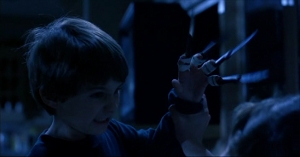
(Still, it would’ve been cool if they’d gotten Whit Hertford for the role. Another visual reference to the previous Nightmare films. Like Tuesday Knight’s presence at Chase’s funeral. What the hell was Hertford doing in 1994, anway? The Land Before Time III? Great career choice there, dude.)
Hughes plays Heather’s son, Dylan, who beings the film plagued by nightmarish visions of mom’s old cinematic foe…despite having never seen a Nightmare movie (mom, naturally, doesn’t want him watching scary movies). Sleep deprivation eventually plunges Dylan into a series of trance-like episodes that Medical Science might mistake for childhood schizophrenia. Dylan’s episodes only worsen after his father dies in an apparent car crash. Poor Chase fell asleep at the wheel while driving home from the set…
After that, Dylan becomes a living MacGuffin – Heather and Freddy’s tug-of-war rope. That’s not what I’d call “optimal.” It’s lazy characterization; Craven following Spielberg’s Law, which clearly states, “Any non-sociopathic audience will instinctively react to an imperiled child, no matter how annoying or one-note they might be.” It’s only the most obvious instance of Craven firing over the heads of his core audience, aiming for the unwashed hordes who ignore and dismiss this series sight unseen. See? he’s saying, these can be real films. I know nobody believes me, but look! Here’s the evidence.
3) It’s so bloody post-modern, it cuts to shots of its own script
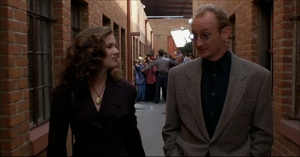
And how is that not awesome?
Alright – like most “post-modern” literature, New Nightmare has a bad habit of sniffing its own ass. Some degree of that’s to be expected from a tenth anniversary film (assuming the series lasts that long), but this film goes you one better. The next time someone asks you to define “post-modern,” you can say this:
“Post-modern is Heather Langenkamp playing an actress named Heather Langenkamp in a Nightmare on Elm Street movie about the makers of Nightmare on Elm Street reuniting to make another one…before the malignant entity our generation knows as ‘Fred Krueger’ no longer confined to his fictional world by a popular and successful film franchise, can breach the wall between worlds and cross over into our dimension, with all his attendant power to turn our nightmares into reality.”
You’re welcome.
This really is Wes Craven’s New Nightmare because Wes Craven wrote and cast himself as the Wise Old Man who tells The Hero exactly what she needs to know in order to get the Third Act going.

After a whole lot of creepy shit – most of it visually echoing creepy shit that happened in the first movie – Heather visits Craven, desperate to know what’s going on in her life and/or his script for the next Nightmare film. Wes tells Heather he’s been dreaming scenes up every night and writing them down in the morning. Scenes that bear a striking resemblance to the film we’ve been watching for the last hour. Earthquakes. Threatening phone calls. Dylan’s episodes. Dreams of Freddy.
And I can’t tell you how nice it is to not have to worry about how the Wise Old Character knows everything they need to know. Because that Wise Old Character is also the writer/director of this film. I know for a fact he’s making it up as he goes along. He up and admits it to Heather (and thus us). For this rare piece of honest Hollywood filmmaking (probably the last in Craven’s career), I salute him. Thanks, Wes. I had you pegged from the get-go, but I’m glad you finally admitted it. If only you hadn’t spent the rest of the ’90s trying to take it back…or half the Naughties trying to make a crappy werewolf movie.
But back to New Nightmare. Craven tells Heather that the thing we call Fred Krueger is merely the latest aspect of an eternal abstract: the Ancient Enemy of Heroes since Time Immemorial. The Big Bad Wolf. The Witch of the Gingerbread House. The Boogeyman. For ten years it’s been trapped inside Freddy’s form and his films. Now, with them “over,” its found a creative use for Freddy’s reality warping power. Bringing us to
4) Freddy’s Hardly in this Movie.
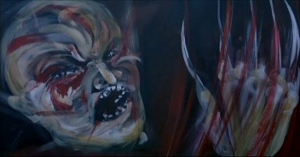
And again I say, “Thank God.” (Which, in this film’s universe, means, “Thank Wes Craven.”) Krueger had more clout and more credibility as a half-seen, nightmare stalker than he ever had as a top-billed starring attraction. That’s my ultimate problem with the first six Nightmare sequels. I can live with stale formula or the reliance on no-name TV actors. This series jumped the shark when it made Freddy its main character.
Someone – I think it was Orson Wells – once said something to the effect of, “As an actor, the best role you can get is the character everyone talks about who only shows up in the last five minutes.” And though Robert Englund shows up to play himself and chat with Heather, Fred Krueger doesn’t show up until we’re well past the hour mark.
As in the first Nightmare, a little goes a long way. This Freddy’s built like a brick shithouse with a biomechanical claw inspired by the original poster artwork for the first movie. Instead of designing elaborate dream worlds, he attacks his targets physically, cutting them up by hand with a level of violence the last three films reserved for their heroes. He adds a Badass Longcoat to his red-and-green sweater and fedora ensemble and, between that one piece of costuming and his plot to get to Heather through Dylan, Freddy trans-mutates back into the child molester he’s always been and always will be, no matter how much his fans lionize him.
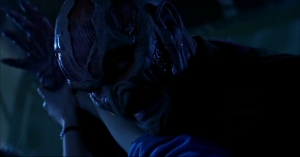
From my perspective, that’s the real tragedy of all this: a sizable chunk of the Nightmare fan base don’t particularly give a shit about movies…or whether those movies are good. They’re not fans of films, they’re fans of Freddy, identifying with the monster because there’s a little monster in all of us, aching to escape.
That’s the monster Dylan’s doctors see in Heather when she shows up – bleeding from claw wounds and babbling about Freddy.
Heather: Every kid knows who Freddy is – he’s like Santa Claus or King Kong.
My favorite non-mythological part of the movie come when Heather faces off against Dr. Christine Heffner (Fran Bennett), the well-meaning busy body who’s “treating” Dylan..like an abuse victim…with Heather as her prime suspect. After all, Freddy’s a myth. But irresponsible parents are very real. If you want to know what really scared horror fans in the mid-90s, look no further than Dr. Nosey and her blandly-compassionate face.
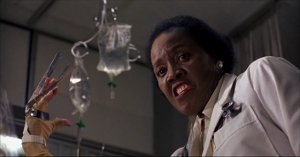
As horror film’s popularity increased throughout the 80s, they became the target of Moral Crusaders not at all unlike Dr. Heffner. Presumably intelligent people (with, like, college degrees and shit) seriously equated allowing your kids to watch horror movies with child abuse. Serious laws meant to criminalize the practice (and a whole mess of other things related to the sale and distribution of everything from music to video games to table top RPGs) were seriously debated in serious legislative chambers. All to protect the mythical innocence of their already-sheltered brats, virtually guaranteeing they’d grow up into the entitled, emotionally stunted prima donnas you see strutting around you today.
Thanks to Spielberg’s Law, all the important people in our society more or less accepted this “objectionable media can push kids over the edge” line without question. People who bitch and moan about “political correctness” and “the language police” forget that there was one thing above all else you were not allowed to talk about in mid-90s America: the social utility of scary stories.
This field of study got a shot in the arm in the mid-80s when Stephen King wrote Danse Macabre, which ends with this sterling defense of the medium,
“It’s the best set of electric trains a boy ever had,” Orson Welles once said of making movies; the same can be said of making books or stories. Here is a chance to burst the [adult’s] tunnel vision open, bricks flying everywhere so that, for a moment at least, a dreamscape of wonders and horrors stands forth as clearly and with all the magic reality of that first Ferris wheel you saw as a kid, turning and turning against the sky. Someone’s dead son is on the late movie. Somewhere a foul man – boogeyman! – is slouching through the snowy night with shinning yellow eyes…
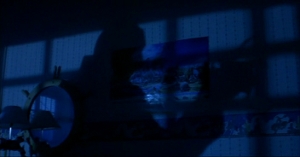
Here is a film openly dramatizing that, along with the effect horror movies actually have on the lives of those who make them. For those who’ve enjoyed them ever since our moms and dads introduced us to the Brothers Grimm, New Nightmare couches itself in the language of fairy tales, making a point Moral Crusaders will bend over backwards (in Bullet Time) to miss. All this helps it avoid simple sequelitis by attempting to be more than another Nightmare on Elm Street movie…while simultaneously drawing in the fact that there are ten years worth of Nightmare on Elm Street movies came before it.
For some, that’s enough to damn it. For me, New Nightmare succeeded on every level. It made me feel like a kid again because it reminded me, “Hot damn, that’s right! Freddy used to be scary!” Thanks for that, Craven, Saint Heather, Robert Englund. Everybody. This is the Nightmare film I show to people who sneer at horror movies; the film that convinced me Craven actually was the Master his partisans made him out to be. It’s the only one that holds a candle to the original in my eyes and a fitting, proper end for the series as a whole.
(So of course they couldn’t leave it there…)
![]()
![]()
![]()
![]()
![]()


Are you saying you’ve never seen The People Under the Stairs, or did I just read that wrong? Good flick there if you haven’t watched it yet:)
I have seen it, didn’t like it, but can see how other people might. People are strange, and the strange people who told me to watch it sold it to me as a comedy, setting-up impossible expectations.
I took it as a horror fantasy with comedic overtones, but its been years and years.